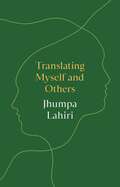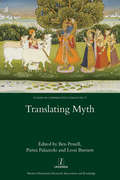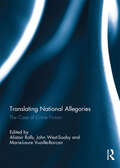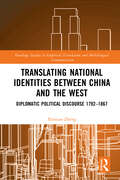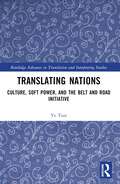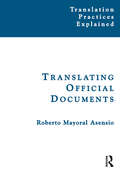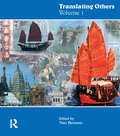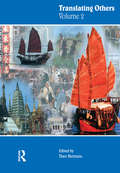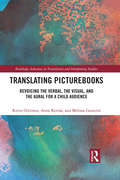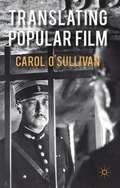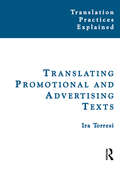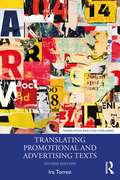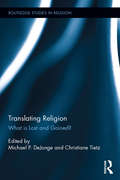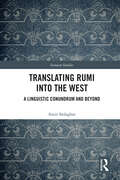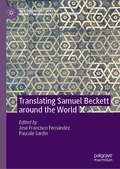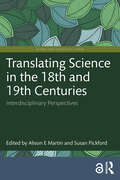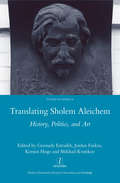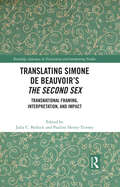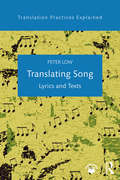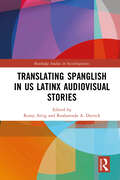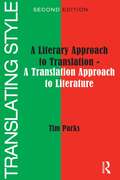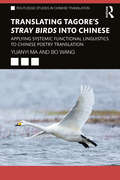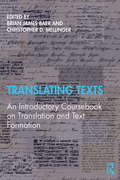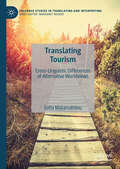- Table View
- List View
Translating Myself and Others
by Jhumpa LahiriLuminous essays on translation and self-translation by the award-winning writer and literary translatorTranslating Myself and Others is a collection of candid and disarmingly personal essays by Pulitzer Prize–winning author Jhumpa Lahiri, who reflects on her emerging identity as a translator as well as a writer in two languages.With subtlety and emotional immediacy, Lahiri draws on Ovid’s myth of Echo and Narcissus to explore the distinction between writing and translating, and provides a close reading of passages from Aristotle’s Poetics to talk more broadly about writing, desire, and freedom. She traces the theme of translation in Antonio Gramsci’s Prison Notebooks and takes up the question of Italo Calvino’s popularity as a translated author. Lahiri considers the unique challenge of translating her own work from Italian to English, the question “Why Italian?,” and the singular pleasures of translating contemporary and ancient writers.Featuring essays originally written in Italian and published in English for the first time, as well as essays written in English, Translating Myself and Others brings together Lahiri’s most lyrical and eloquently observed meditations on the translator’s art as a sublime act of both linguistic and personal metamorphosis.
Translating Myth (Legenda)
by Ben Pestell Pietra Palazzolo Leon BurnettEver since Odysseus heard tales of his own exploits being retold among strangers, audiences and readers have been alive to the complications and questions arising from the translation of myth. How are myths taken and carried over into new languages, new civilizations, or new media? An international group of scholars is gathered in this volume to present diverse but connected case studies which address the artistic and political implications of the changing condition of myth – this most primal and malleable of forms. ‘Translation’ is treated broadly to encompass not only literary translation, but also the transfer of myth across cultures and epochs. In an age when the spiritual world is in crisis, Translating Myth constitutes a timely exploration of myth’s endurance, and represents a consolidation of the status of myth studies as a discipline in its own right.
Translating National Allegories: The Case of Crime Fiction
by Alistair Rolls, John West-Sooby and Marie-Laure Vuaille-BarcanThis book explores the intersection of a number of academic areas of study that are all, individually, of growing importance: translation studies, crime fiction and world literature. The scholars included here are leaders in one or more of these areas. The frame of this volume is imagological; its focus is on the ways in which national allegories are constructed and deconstructed, encompassing descriptions of national characteristics as they play out at the level of the local or the individual as well as broader, political analyses. Its corpus, crime fiction, is shown to be a privileged site for writing the national narrative, and often in ways that are more complex and dynamic than is suggested by the genre’s much-cited role as vehicle for a new realism. Finally, these two areas are problematised through the lens of translation, which is a crucial player in both the development of crime fiction and the formation, rather than simply the interlingual transfer, of national allegory. In this volume national allegories, and the crime novels in which they emerge, are shown to be eminently versatile, foundationally plural texts that promote critical rewriting as opposed to sites for fixing meaning. This book was originally published as a special issue of The Translator.
Translating National Identities Between China and the West: Diplomatic Political Discourse 1792–1867 (Routledge Studies in Empirical Translation and Multilingual Communication)
by Xinnian ZhengThis book explores the discursive construction of national identities in diplomatic political discourse, focusing on translation’s pivotal role. It examines diplomatic exchanges between China and the West from 1792 to 1867, a period marked by China’s national identity crisis. By combining Descriptive Translation Studies (DTS) with Discourse-Historical Approach (DHA), the book uncovers how translation shaped the national identities of both China and the West during a time of intercultural conflict and change.Through the analysis of 29 authentic historical documents, the book offers a groundbreaking analysis of how translators at the Qing court initially portrayed China as superior and the West as inferior. However, as China’s global position shifted, so did its translation strategies, gradually transforming China’s national identity to be seen as equal to the West. During diplomatic interactions, translators played a crucial role in shaping perceptions of both Chinese and Western identities, thereby influencing international relations.Essential for scholars and students of translation studies, political discourse, and Chinese history, this book goes beyond traditional analysis, offering a new perspective on the intricate relationship between translation, power, and identity. Its blend of qualitative and quantitative methods provides a comprehensive view of East-West relations during a pivotal period in world history.
Translating Nations: Culture, Soft Power, and the Belt and Road Initiative (Routledge Advances in Translation and Interpreting Studies)
by Ye TianThis book critically examines the ways in which translation studies can offer a conceptual framework for understanding and researching international affairs, drawing on examples from China’s Belt and Road Initiative.The volume encourages new conceptualisations of our understanding of culture and communication through the lens of translation, re-envisioning translation beyond the scope of the global circulation of cultural products. Tian explores the case study of the Belt and Road Initiative to show how nation branding and soft power can be understood through a translational lens if we rethink of translation as the means by which cultures communicate and build relationships with each other while retaining their distinct dimensions. In focusing on intertwining concepts across translation studies, cultural studies, and international relations – universalism, power, identity, and development – the book showcases how it is a useful framework for understanding how translation studies can serve as a platform for multidisciplinary dialogue on a global scale.This book will be of interest to scholars in translation studies, cultural studies, international relations, and Asian studies.
Translating Official Documents (Translation Practices Explained)
by Roberto Mayoral AsensioOfficial translations are generally documents that serve as legally valid instruments. They include anything from certificates of birth, death or marriage through to academic transcripts or legal contracts. This field of translation is now as important as it is fraught with difficulties, for it is only in a few areas that the cultural differences are so acute and the consequences of failure so palpable. In a globalizing world, our official institutions increasingly depend on translations of official documents, but little has been done to elaborate the skills and dilemmas involved. Roberto Mayoral deals with the very practical problems of official translating. He points out the failings of traditional theories in this field and the need for revised concepts such as the virtual document, pragmatic constraints, and risk analysis. He details aspects of the social contexts, ethical norms, translation strategies, different formats, fees, legal formulas, and ways of solving the most frequent problems. Care is taken to address as wide a range of cultural contexts as possible and to stress the active role of the translator. This book is intended as a teaching text for the classroom, for self-learning, or for professionals who want to reflect on their practice. Activities and exercises are suggested for each chapter, and information is included on professional associations and societies across the globe.
Translating Others (Volume 1)
by Theo HermansBoth in the sheer breadth and in the detail of their coverage the essays in these two volumes challenge hegemonic thinking on the subject of translation. Engaging throughout with issues of representation in a postmodern and postcolonial world, Translating Others investigates the complex processes of projection, recognition, displacement and 'othering' effected not only by translation practices but also by translation studies as developed in the West. At the same time, the volumes document the increasing awareness the the world is peopled by others who also translate, often in ways radically different from and hitherto largely ignored by the modes of translating conceptualized in Western discourses. The languages covered in individual contributions include Arabic, Bengali, Chinese, Hindi, Irish, Italian, Japanese, Latin, Rajasthani, Somali, Swahili, Tamil, Tibetan and Turkish as well as the Europhone literatures of Africa, the tongues of medieval Europe, and some major languages of Egypt's five thousand year history. Neighbouring disciplines invoked include anthropology, semiotics, museum and folklore studies, librarianship and the history of writing systems. Contributors to Volume 1: Doris Bachmann-Medick, Cosima Bruno, Ovidi Carbonell, Martha Cheung, G. Gopinathan, Eva Hung, Alexandra Lianeri, Carol Maier, Christi Ann Marrill, Paolo Rambelli, Myriam Salama-Carr, Ubaldo Stecconi and Maria Tymoczko.
Translating Others (Volume 2)
by Theo HermansBoth in the sheer breadth and in the detail of their coverage the essays in these two volumes challenge hegemonic thinking on the subject of translation. Engaging throughout with issues of representation in a postmodern and postcolonial world, Translating Others investigates the complex processes of projection, recognition, displacement and 'othering' effected not only by translation practices but also by translation studies as developed in the West. At the same time, the volumes document the increasing awareness the the world is peopled by others who also translate, often in ways radically different from and hitherto largely ignored by the modes of translating conceptualized in Western discourses. The languages covered in individual contributions include Arabic, Bengali, Chinese, Hindi, Irish, Italian, Japanese, Latin, Rajasthani, Somali, Swahili, Tamil, Tibetan and Turkish as well as the Europhone literatures of Africa, the tongues of medieval Europe, and some major languages of Egypt's five thousand year history. Neighbouring disciplines invoked include anthropology, semiotics, museum and folklore studies, librarianship and the history of writing systems. Contributors to Volume 2: Paul Bandia, Red Chan, Sukanta Chaudhuri, Annmarie Drury, Ruth Evans, Fabrizio Ferrari, Daniel Gallimore, Hephzibah Israel, John Tszpang Lai, Kenneth Liu-Szu-han, Ibrahim Muhawi, Martin Orwin, Carol O'Sullivan, Saliha Parker, Stephen Quirke and Kate Sturge.
Translating Pain
by Madelaine HronIn the post-Cold War, post-9/11 era, the immigrant experience has changed dramatically. Despite the recent successes of immigrant and world literatures, there has been little scholarship on how the hardships of immigration are conveyed in immigrant narratives. Translating Pain fills this gap by examining literature from Muslim North Africa, the Caribbean, and Eastern Europe to reveal the representation of immigrant suffering in fiction.Applying immigrant psychology to literary analysis, Madelaine Hron examines the ways in which different forms of physical and psychological pain are expressed in a wide variety of texts. She juxtaposes post-colonial and post-communist concerns about immigration, and contrasts Muslim world views with those of Caribbean creolité and post-Cold War ethics. Demonstrating how pain is translated into literature, she explores the ways in which it also shapes narrative, culture, history, and politics. A compelling and accessible study, Translating Pain is a groundbreaking work of literary and postcolonial studies.
Translating Picturebooks: Revoicing the Verbal, the Visual and the Aural for a Child Audience (Routledge Advances in Translation and Interpreting Studies)
by Riitta Oittinen Anne Ketola Melissa GaraviniTranslating Picturebooks examines the role of illustration in the translation process of picturebooks and how the word-image interplay inherent in the medium can have an impact both on translation practice and the reading process itself. The book draws on a wide range of picturebooks published and translated in a number of languages to demonstrate the myriad ways in which information and meaning is conveyed in the translation of multimodal material and in turn, the impact of these interactions on the readers’ experiences of these books. The volume also analyzes strategies translators employ in translating picturebooks, including issues surrounding culturally-specific references and visual and verbal gaps, and features a chapter with excerpts from translators’ diaries written during the process. Highlighting the complex dynamics at work in the translation process of picturebooks and their implications for research on translation studies and multimodal material, this book is an indispensable resource for students and researchers in translation studies, multimodality, and children’s literature.
Translating Popular Film
by Carol O'Sullivan 2011A ground-breaking study of the roles played by foreign languages in film and television and their relationship to translation. The book covers areas such as subtitling and the homogenising use of English, and asks what are the devices used to represent foreign languages on screen?
Translating Promotional and Advertising Texts
by Ira TorresiPromotional and advertising texts come in different forms and account for a considerable share of the translation market. Advertisements, company brochures, websites, tourist guides, institutional information campaigns, and even personal CVs all share a common primary purpose: that of persuading the reader to buy something, be it a product or a lifestyle, or to act in a particular way, from taking preventive measures against health risks to employing one candidate in preference to another. Consequently, their translation requires the application of techniques which, although they vary depending on the specific text type, are all aimed at preserving that persuasive purpose. This often requires in-depth cultural adaptation and, on occasion, thorough rewriting. Translating Promotional and Advertising Texts covers different areas of personal promotion, business to business promotion, institutional and business to consumer promotion, including advertising. Numerous examples from a wide variety of languages and media, taken from the author's own professional experience and from real-life observation, are provided throughout. The volume is designed for use as a coursebook for classroom practice or as a handbook for self-learning. It will be of interest to undergraduate and postgraduate students, but also freelance and in-house translators, as well as other professionals working in sales, public relations or similar departments whose responsibilities include involvement in the management of multilingual advertising and promotion activities.
Translating Promotional and Advertising Texts (Translation Practices Explained)
by Ira TorresiThe translation of promotional and advertising texts requires the application of techniques which, although they vary depending on the specific text type, are all aimed at preserving their persuasive purpose. This often requires in-depth cultural adaptation and, on occasion, thorough rewriting. Translating Promotional and Advertising Texts covers the key types of promotional texts, including personal, business-to-business, institutional, business-to-consumer, and advertising. With numerous examples from a wide variety of languages and media, taken from the author's own professional experience and observations, this volume is designed for use as a coursebook for classroom practice or as a handbook for self-learning. It also provides insight for research into promotional and advertising translation. This second, updated edition offers entirely new sections on self-promotion in social media, text analysis, and tools for the cross-cultural appraisal of promotional texts. Revised with new examples, a glossary of terms, and activities and tasks on the Routledge Translation Studies Portal, this is the essential text for students, researchers, translators, and professionals working in copywriting, marketing, public relations, or related areas.
Translating Religion: What is Lost and Gained? (Routledge Studies in Religion)
by Michael DeJonge Christiane TietzTranslating Religion advances thinking about translation as a critical category in religious studies, combining theoretical reflection about processes of translation in religion with focused case studies that are international, interdisciplinary, and interreligious. By operating with broad conceptions of both religion and translation, this volume makes clear that processes of translation, broadly construed, are everywhere in both religious life and the study of religion; at the same time, the theory and practice of translation and the advancement of translation studies as a field has developed in the context of concerns about the possibility and propriety of translating religious texts. The nature of religions as living historical traditions depends on the translation of religion from the past into the present. Interreligious dialogue and the comparative study of religion require the translation of religion from one tradition to another. Understanding the historical diffusion of the world’s religions requires coming to terms with the success and failure of translating a religion from one cultural context into another. Contributors ask what it means to translate religion, both textually and conceptually, and how the translation of religious content might differ from the translation of other aspects of human culture. This volume proposes that questions on the nature of translation find particularly acute expression in the domains of religion, and argues that theoretical approaches from translation studies can be fruitfully brought to bear on contemporary religious studies.
Translating Rumi into the West: A Linguistic Conundrum and Beyond (Iranian Studies)
by Amir SedaghatFocusing on Rumi, the best-selling Persian mystical poet of the 13th century, this book investigates the reception of his work and thought in North America and Europe – and the phenomenon of ‘Rumimania’ – to elucidate the complexities of intercultural communication between the West and the Iranian and Islamic worlds. Presenting tens of examples from the original and translated texts, the book is a critical analysis of various dimensions of this reception, outlining the difficulties of translating the text but also exploring how translators of various times and languages have performed, and explaining why the quality of reception varies. Topics analysed include the linguistic and pragmatic issues of translation, comparative stylistics and poetics, and non-textual factors like the translator’s beliefs and the political and ideological aspects of translation. Using a broad theoretical framework, the author highlights the difficulties of intercultural communication from linguistic, semiotic, stylistic, poetic, ethical, and sociocultural perspectives. Ultimately, the author shares his reflections on the semiotic specificities of Rumi’s mystical discourse and the ethics of translation generally. The book will be valuable to scholars and students of Islamic philosophy, Iranian studies, and translation studies, but will appeal to anyone interested in the cultural dichotomies of the West and Islam.
Translating Samuel Beckett around the World (New Interpretations of Beckett in the Twenty-First Century)
by José Francisco Fernández Pascale SardinThe global reception of Samuel Beckett raises numerous questions: in which areas of the world was Beckett first translated? Why were Beckett texts sometimes slow to penetrate certain cultures? How were national literatures impacted by Beckett's oeuvre? Translating Samuel Beckett around the World brings together leading researchers in Beckett studies to discuss these questions and explore the fate of Beckett in their own societies and national languages. The current text provides ample coverage of the presence of Beckett in geographical contexts normally ignored by literary criticism, and reveals unknown aspects of the 1969 Nobel Prize winner interacting with translators of his work in a number of different countries.
Translating Science in the 18th and 19th Centuries: Interdisciplinary Perspectives (Science and Technology Studies)
by Alison E. Martin and Susan PickfordThis book explores the role of translation in shaping the knowledge-sharing processes that were and are seminal to scientific endeavour. It considers the mechanisms by which eighteenth- and nineteenth-century European science writing travelled within and beyond its home continent and non- European science was taken up in a colonial context. Using insights from fields of research including book history and textual studies to investigate the paratextual framing, stylistic choices, rhetorical devices, and modes of expression deployed by scientific writers – key to shaping a work’s credibility and its author’s integrity –it argues that translators are central, yet largely overlooked, mediators in this creative process.Encompassing West Africa, China, the Middle East, India, South America, Europe, and the Ottoman Empire, this volume comprises case studies working with around a dozen different languages to gain a sense of how scientific narratives were evolving both within and across an increasingly global intellectual commons in a key period in the development of the natural sciences, medicine, and technology.Part of the Science and Technology Studies series, the volume will be indispensable for scholars and researchers of science and technology studies, philosophy of science, translation studies, gender studies, English literature, and philosophy in general.
Translating Sholem Aleichem: History, Politics and Art
by Gennady EstraikhSholem Aleichem, whose 150th anniversary was commemorated in March 2009, remains one of the most popular Yiddish authors. But few people today are able to read the original. Since the 1910s, however, Sholem Aleichem's works have been known to a wider international audience through numerous translations, and through film and theatre adaptations, most famouslyFiddler on the Roof. This volume examines those translations published in Europe, with the aim of investigating how the specific European contexts might have shaped translations of Yiddish literature. With the contributions: Olga Litvak- Found in Translation: Sholem Aleichem and the Myth of the Ideal Yiddish Reader Alexander Frenkel- Sholem Aleichem as a Self-Translator Eugenia Prokop-Janiec- Sholem Aleichem and the Polish-Jewish Literary Audience Gennady Estraikh- Soviet Sholem Aleichem Roland Gruschka- 'Du host zikh a denkmol af eybik geshtelt': The Sovietization and Heroization of Sholem Aleichem in the 1939 Jubilee Poems Mikhail Krutikov- A Man for All Seasons: Translating Sholem Aleichem into Soviet Ideological Idiom Gabriella Safran- Four English Pots and the Evolving Translatability of Sholem Aleichem Sabine Koller- On (Un)Translatability: Sholem Aleichem's Ayznban-geshikhtes (Railroad Stories) in German Translation Alexandra Hoffman- Laughing Matters: Translation and Irony in 'Der gliklekhster in Kodne' Kerstin Hoge- Lost in Marienbad: On the Literary Use of the Linguistic Openness of Yiddish Anna Verschik- Sholem Aleichem in Estonian: Creating a Tradition Jan Schwarz- Speaking Tevye der milkhiker in Translation: Performance, Humour, and World Literature
Translating Simone de Beauvoir’s The Second Sex: Transnational Framing, Interpretation, and Impact (Routledge Advances in Translation and Interpreting Studies)
by Bullock Julia C.This collection offers insights into the transnational and translingual implications of Simone de Beauvoir’s Le Deuxième Sexe (The Second Sex), a text that has served as foundational for feminisms worldwide since its publication in 1949. Little scholarly attention has been devoted to how the original French-language source text made its way into languages other than English. This is a shocking omission, given that many (but by no means all) other translations were based on the 1953 English translation by Howard M. Parshley, which has been widely criticized by Beauvoir scholars for its omissions and careless attention to its philosophical implications. This volume seeks to fill this gap in scholarship with an innovative collection of essays that interrogate the ways that Beauvoir’s essay has shifted in meaning and significance as it has travelled across the globe. This volume brings together for the first time scholars from Translation Studies, Literary Studies and Philosophical Studies, and over half of it is dedicated to non-Western European engagements with Le Deuxième Sexe (including chapters on the Chinese, Japanese, Arabic, Hungarian and Polish translations). As such, this collection will be essential to any scholar of Beauvoir’s philosophy and its contributions to feminist discourses.
Translating Song: Lyrics and Texts (Translation Practices Explained)
by Peter LowThis engaging step-by-step guide prescribes effective strategies and tactics for translating a wide range of songs and other vocal music, from classical to contemporary. Focusing on best practice and with a variety of language examples, the book centres on four key themes: translating songs for a range of recipients and within different contexts (skopos theory) translating songs for reading on paper or on screens (surtitles and subtitles) "singable translations" and the Pentathlon Approach translating expressive texts. With a substantial introduction, six insightful chapters, further reading and a glossary of key terms (also available at https://www.routledge.com/9781138641792 and on the Routledge Translation Studies Portal), this lively and clear student-friendly guide is essential for students, researchers and practitioners involved in or studying the practice of translating music. This will also be an engaging read for musicians and all those interested in the study of music.
Translating Spanglish in US Latinx Audiovisual Stories (Routledge Studies in Sociolinguistics)
by Attig, Edited by RemyThis collection showcases interdisciplinary perspectives on how Spanglish is translated across different forms of audiovisual media for different audiences in the US Latinx content.The volume explores the ways in which Spanglish is used in American media to portray the hallmark linguistic characteristics of the communities in which they are set, but also the different scholarly approaches employed to analyze them in existing research. The first section looks at the interplay of code-switching, translanguaging, and linguistic identity in television shows and films but also podcasts, music, and other emergent forms of media. The second part examines US Latinx stories through the lens of translation studies, with chapters showcasing different lines of inquiry within contemporary translation scholarship, including accessibility via captioning and interlingual translation through subtitling and dubbing. Taken together, the volume offers a holistic view on how Spanglish is translated in US Latinx stories towards paving the way for future research in this context but also on multilingual and translingual audiovisual stories more broadly.This book will be of interest to scholars in sociolinguistics, translation studies, language and media, media studies, and Latinx studies.
Translating Style: A Literary Approach to Translation - A Translation Approach to Literature
by Tim ParksArising from a dissatisfaction with blandly general or abstrusely theoretical approaches to translation, this book sets out to show, through detailed and lively analysis, what it really means to translate literary style. Combining linguistic and lit crit approaches, it proceeds through a series of interconnected chapters to analyse translations of the works of D.H. Lawrence, Virginia Woolf, James Joyce, Samuel Beckett, Henry Green and Barbara Pym. Each chapter thus becomes an illuminating critical essay on the author concerned, showing how divergences between original and translation tend to be of a different kind for each author depending on the nature of his or her inspiration. This new and thoroughly revised edition introduces a system of 'back translation' that now makes Tim Parks' highly-praised book reader friendly even for those with little or no Italian. An entirely new final chapter considers the profound effects that globalization and the search for an immediate international readership is having on both literary translation and literature itself.
Translating Tagore's Stray Birds into Chinese: Applying Systemic Functional Linguistics to Chinese Poetry Translation (Routledge Studies in Chinese Translation)
by Bo Wang Yuanyi MaTranslating Tagore’s ‘Stray Birds’ into Chinese explores the choices in poetry translation in light of Systemic Functional Linguistics (SFL) and illustrates the ways in which readers can achieve a deeper understanding of translated works in English and Chinese. Focusing on Rabindranath Tagore’s ‘Stray Birds’, a collection of elegant and philosophical poems, as a source text, Ma and Wang analyse four Chinese target texts by Zheng Zhenduo, Yao Hua, Lu Jinde and Feng Tang and consider their linguistic complexities through SFL. This book analyses the source text and the target texts from the perspectives of the four strata of language, including graphology, phonology, lexicogrammar and context. Ideal for researchers and academics of SFL, Translation Studies, Linguistics, and Discourse Analysis, Translating Tagore’s ‘Stray Birds’ into Chinese provides an in-depth exploration of SFL and its emerging prominence in the field of Translation Studies.
Translating Texts: An Introductory Coursebook on Translation and Text Formation
by Brian James Baer Christopher D. MellingerClear and accessible, this textbook provides a step-by-step guide to textual analysis for beginning translators and translation students. Covering a variety of text types, including business letters, recipes, and museum guides in six languages (Chinese, English, French, German, Russian, and Spanish), this book presents authentic, research-based materials to support translation among any of these languages. Translating Texts will provide beginning translators with greater text awareness, a critical skill for professional translators. Including discussions of the key theoretical texts underlying this text-centred approach to translation and sample rubrics for (self) assessment, this coursebook also provides easy instructions for creating additional corpora for other text types and in other languages. Ideal for both language-neutral and language-specific classroom settings, this is an essential text for undergraduate and graduate-level programs in modern languages and translation.
Translating Tourism: Cross-Linguistic Differences of Alternative Worldviews (Palgrave Studies in Translating and Interpreting)
by Sofia MalamatidouThis book provides a large-scale empirical multilingual study of crosslinguistic differences in the language of destination promotion. The book explores how tourism texts are negotiated in translation, and how the translated texts reflect and reconcile different worldviews, that of the destination population and that of the tourist. Using the 2-million-word TrAIL (Tourism Across and & In-between Languages) corpus, which includes examples from official tourism websites in English, French, Greek, and Russian as well as translations between these languages, the author explores the differences in the key linguistic means used in destination promotion and what these linguistic choices can tell us about how these societies view the world around them differently. The book’s interdisciplinary focus makes it relevant to not only practising translators, but also students and scholars interested in issues surrounding tourism, promotion, and translation, as well as destination promoters who want to better understand the role that language and translation play in tourism promotion.
